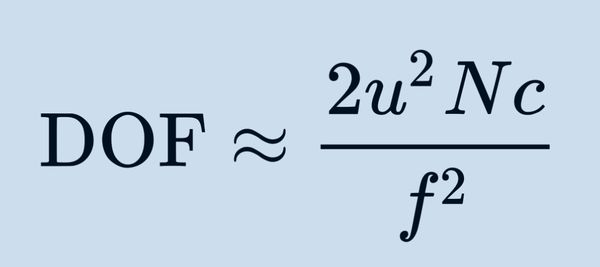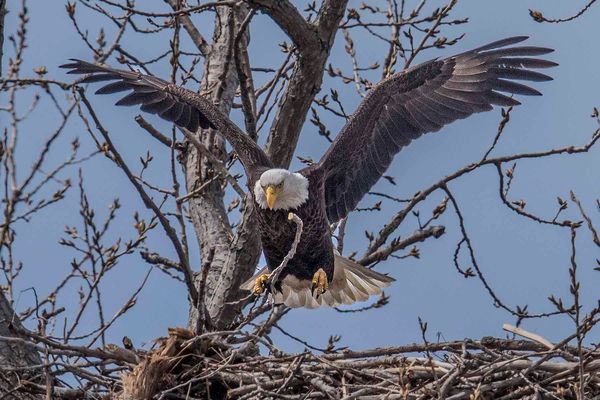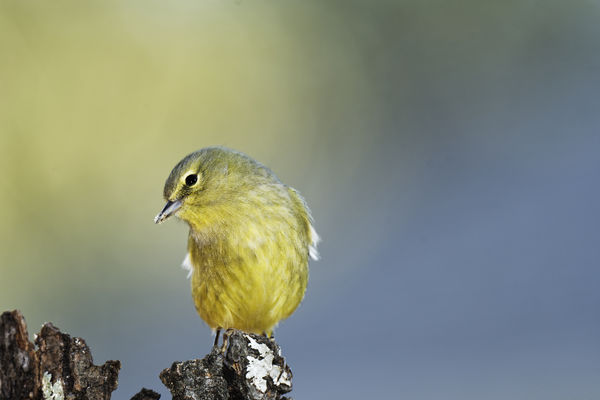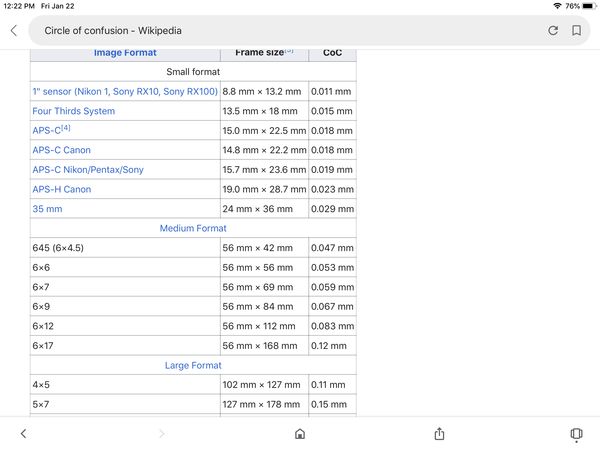depth of field
Jan 22, 2021 10:28:14 #
Leitz wrote:
Someone posted this chart before (you?). I was skeptical at first, but the following calculator proves that depth of field is determined by magnification ratio and aperture. Still, many insist that focal length and distance matters.
http://www.photopills.com/calculators/dof-macro
http://www.photopills.com/calculators/dof-macro
And circle of confusion. (From Wiki)
The depth of field can be determined by focal length, distance to subject, the acceptable circle of confusion size, and aperture.[2] The approximate depth of field can be given by:

Jan 22, 2021 10:30:31 #
JOHNERIKSSON wrote:
I am showing a northern cardinal picture I took with my Canon 600 f4 and 1DX mark III
the bill and eye are tack sharp, but the breast feathers, feet and finally the tail are badly out of focus. So my question is what kind of camera settings do I need to make all the bird sharp these were iso 800, f5.6 and 1/3200. How would you set up the camera to get better results. Or would you take several pictures with different focus points and combine them?
the bill and eye are tack sharp, but the breast feathers, feet and finally the tail are badly out of focus. So my question is what kind of camera settings do I need to make all the bird sharp these were iso 800, f5.6 and 1/3200. How would you set up the camera to get better results. Or would you take several pictures with different focus points and combine them?
When you are close to a subject, like the closest focus distance for a lens, the depth of field range is very small, with 50% in front of the focus point and 50% behind. Stopping down the lens to a smaller aperture helps, but not by a lot, and it might make the background in better focus, which may not be that desirable. With tele lenses from 300mm to 600mm, it is quite common to get feather detail out of focus if the eye is in focus, if you are close to the subject. '
Use this tool:
https://www.dofmaster.com/dofjs.html
Jan 22, 2021 10:31:02 #
Leitz
Loc: Solms
SuperflyTNT and frankraney -
Magnification can be determined by dividing subject size by image size. For the online calculators, you do need to enter both the focal length and distance. Note that the chart posted above does not mention either.
Magnification can be determined by dividing subject size by image size. For the online calculators, you do need to enter both the focal length and distance. Note that the chart posted above does not mention either.
Jan 22, 2021 10:37:29 #
frankraney wrote:
You can get close depth of field with an app, hyper focal pro, and also get a better understanding of depth of field by using it.
Here is a bird I shot with the 600mmF:4 G VR. Position has a lot to do with results. Here the bird is parallel with the sensor and I used fill flash here. The eagle was shot using the 600mm but at a greater distance. You will always get more DoF at greater distance. Almost all of my warbler work is done with a 300mmF:4 AFS and with flash. I would encourage you to fprward your email so I can send the birding PDF.


Jan 22, 2021 10:44:41 #
Leitz wrote:
SuperflyTNT and frankraney -
Magnification can be determined by dividing subject size by image size. For the online calculators, you do need to enter both the focal length and distance. Note that the chart posted above does not mention either.
Magnification can be determined by dividing subject size by image size. For the online calculators, you do need to enter both the focal length and distance. Note that the chart posted above does not mention either.
And it specifies a set CoC, which is NOT the same for all formats - and it makes a very substantial difference, which is why a calculator such as DofMaster is useful. Very easy to put the ap on your phone.
Jan 22, 2021 10:56:14 #
Here is an uncropped picture taken a few days ago. D 500, 500mm f5.6 pf lens, 1.4x tc, fill flash. Aperture was f 8 and the shutter speed was below 1/100. Note the difference in feather detail in focus at base of bird vs its face.

Jan 22, 2021 10:58:47 #
The web version of these calculators are free, but there is a reasonable fee for the phone app. If your camera is not on the list choose one with the same size sensor.
https://www.photopills.com/calculators/dof-advanced
Good article too https://www.photopills.com/articles/depth-of-field-guide
https://www.photopills.com/calculators/dof-advanced
Good article too https://www.photopills.com/articles/depth-of-field-guide
Jan 22, 2021 11:06:05 #
Leitz
Loc: Solms
TriX wrote:
And circle of confusion. (From Wiki)
The depth of field can be determined by focal length, distance to subject, the acceptable circle of confusion size, and aperture.[2] The approximate depth of field can be given by:
The depth of field can be determined by focal length, distance to subject, the acceptable circle of confusion size, and aperture.[2] The approximate depth of field can be given by:
Yes indeed - the circle of confusion is an essential part of the equation. Most charts use 1/30mm for 24x36 format. Someplace I have a list of recommended sizes for all common formats, from 24x36mm to at least 4x5".
Jan 22, 2021 11:57:27 #
It certainly is, and with close up photography or macro photography it is far easier to forget about the distance and to evaluate everything on the basis of magnification or, as it is sometimes called, Ratio of Reproduction. This does away with all of the problem about whether wide-angle lenses have a greater depth of field than a long focus lens-they are both the same if the images from the two lenses are the same magnification.
Circle of confusion is certainly extremely important as it depends upon the magnification of the final image. In other words with a poster size print, a smaller circle of confusion would have to be used then for a regular 8 x 10.
Circle of confusion is certainly extremely important as it depends upon the magnification of the final image. In other words with a poster size print, a smaller circle of confusion would have to be used then for a regular 8 x 10.
Jan 22, 2021 12:23:21 #
Leitz wrote:
Yes indeed - the circle of confusion is an essential part of the equation. Most charts use 1/30mm for 24x36 format. Someplace I have a list of recommended sizes for all common formats, from 24x36mm to at least 4x5".
Here’s one.
Cheers

Jan 22, 2021 13:11:49 #
JOHNERIKSSON wrote:
I am showing a northern cardinal picture I took with my Canon 600 f4 and 1DX mark III
the bill and eye are tack sharp, but the breast feathers, feet and finally the tail are badly out of focus. So my question is what kind of camera settings do I need to make all the bird sharp these were iso 800, f5.6 and 1/3200. How would you set up the camera to get better results. Or would you take several pictures with different focus points and combine them?
the bill and eye are tack sharp, but the breast feathers, feet and finally the tail are badly out of focus. So my question is what kind of camera settings do I need to make all the bird sharp these were iso 800, f5.6 and 1/3200. How would you set up the camera to get better results. Or would you take several pictures with different focus points and combine them?
Another app, which I use on my iPhone, is "Digital Depth of Field;" I've no idea if it is available for other phones. It is free, but they keep trying to get me to upgrade to a version that isn't. I think some new cameras are not included, but many many are. You enter your camera, lens focal length, aperture, and distance (Imperial or metric), and it gives you depth of field, distance in front of the focus point, distance behind, as well as a few other interesting details.
Jan 22, 2021 13:54:47 #
Leitz
Loc: Solms
TriX wrote:
Here’s one. Cheers
This is a lot more complete than whatever I have. Much appreciated!
Jan 22, 2021 13:55:15 #
Lots of great answers here!
But raises a related question. Why isn't the DOF shown in the viewfinder?
If you have a mirrorless camera with focus peaking, try that out. I use it quite a bit and its helped in situations like this.
But raises a related question. Why isn't the DOF shown in the viewfinder?
If you have a mirrorless camera with focus peaking, try that out. I use it quite a bit and its helped in situations like this.
Jan 22, 2021 14:27:06 #
wdross
Loc: Castle Rock, Colorado
JOHNERIKSSON wrote:
I am showing a northern cardinal picture I took with my Canon 600 f4 and 1DX mark III
the bill and eye are tack sharp, but the breast feathers, feet and finally the tail are badly out of focus. So my question is what kind of camera settings do I need to make all the bird sharp these were iso 800, f5.6 and 1/3200. How would you set up the camera to get better results. Or would you take several pictures with different focus points and combine them?
the bill and eye are tack sharp, but the breast feathers, feet and finally the tail are badly out of focus. So my question is what kind of camera settings do I need to make all the bird sharp these were iso 800, f5.6 and 1/3200. How would you set up the camera to get better results. Or would you take several pictures with different focus points and combine them?
With full frame, the depth of field is narrow at f5.6. Try f11 next time. And I would let the ISO go up two stops over what you shot. These are some of the differences and trade-offs between formats. Full frame blurs the backgrounds better than 4/3rds. But at the exact same settings you used for the exact same angle of view, my 4/3rds would provide an f11 full frame depth of view at the f5.6 setting. You will get better ISO noise ratio and suppression than I will get as you increase ISO compared to my 4/3rds. Always a trade-off between formats.
Jan 22, 2021 14:57:17 #
If you want to reply, then register here. Registration is free and your account is created instantly, so you can post right away.


